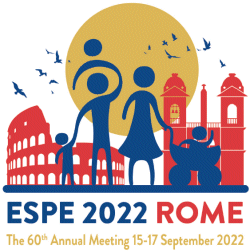
60th Annual ESPE (ESPE 2022)
Rome,
Italy
15 Sep 2022 - 17 Sep 2022
Rapid Free Communications
Late Breaking
hrp0095rfc11.1 | Late Breaking | ESPE2022
Six-months of treatment with exenatide improves glycemic control, but does not affect endogenous intact GLP-1 concentrations in adolescents with obesity
Stenlid Rasmus , Y. Cerenius Sara , K. Aydin Banu , S. Gjessing Erik , Manell Hannes , Weghuber Daniel , Forslund Anders , Bergsten Peter
hrp0095rfc11.2 | Late Breaking | ESPE2022
Dynamics of meal-related plasma asprosin levels
Corica Domenico , Pepe Giorgia , Aversa Tommaso , Currò Monica , Curatola Selenia , Li Pomi Alessandra , Alibrandi Angela , Ientile Riccardo , Wasniewska Malgorzata
hrp0095rfc11.3 | Late Breaking | ESPE2022
Predictors of kidney damage development in children with metabolically healthy and metabolically unhealthy obese phenotypes
Di Sessa Anna , Paride Passaro Antonio , Maria Colasante Alberto , Ferrara Serena , Rosaria Umano Giuseppina , Marzuillo Pierluigi , Miraglia del Giudice Emanuele
hrp0095rfc11.4 | Late Breaking | ESPE2022
Are GnRH agonists beneficial in final adult height after 8 years old? Data from a Portuguese National Digital Platform of idiopathic Central Precocious Puberty
Espada Filipa , Castro Carolina , Luisa Leite Ana , Galo Elisa , Antunes Ana , Castro Sofia , Robalo Brigida , Amaral Daniela , Ferreira Sofia , Limbert Catarina
hrp0095rfc11.5 | Late Breaking | ESPE2022
Dasiglucagon Treatment Over 21 days in Infants with Congenital Hyperinsulinism Results in Glycaemic Stability and Reduces Requirement for Intravenous Glucose
Banerjee Indraneel , D. De Leon Diva , M. Kendall David , Birch Sune , Bøge Eva , Ivkovic Jelena , S Thornton Paul , Nurdan Ciftci , Huseyin Demirbilek
hrp0095rfc11.6 | Late Breaking | ESPE2022
Genotype, phenotype characteristics and long-term follow-up of patients with Vitamin D Dependent Rickets Type IA (VDDR1a): A nationwide multicentre retrospective cross-sectional study
Cayir Atilla , Demirbilek Huseyin , Turkyılmaz Ayberk , Turan Serap , Bereket Abdullah , Darendeliler Feyza , Nuri Özbek Mehmet , Ünal Edip , Okdemir Deniz , Esen Ihsan , Eren Erdal , Yıldırım Ruken , Çetinkaya Semra , Cansu Sahin Kadriye , Anık Ahmet , Sena Dönmez Ayşe , Pınar Öztürk Ayşe , Bayramoğlu Elvan , Buyukinan Muammer , Gurbuz Fatih , Demir Korcan , Kılınç Suna , Betul Kaygusuz Sare , Çelmeli Gamze , Selvi Eklioglu Beray , Acar Sezer , Dursun Fatma , Turan Ihsan , Özkaya Beyhan , Kurnaz Erdal , Taner Baran Rıza , Özkan Behzat



